Quantity Surveying 1: Bill of Quantity for Wall Finishes, Ceilings
VerifiedAdded on 2021/06/14
|6
|1427
|317
Report
AI Summary
This report provides a detailed analysis of a bill of quantity (BOQ) for a construction project, focusing on wall finishes, ceiling, and interior finishes. The document explains the significance of a BOQ in construction, highlighting its role in material procurement, labor costing, and tendering processes. It includes a breakdown of various elements such as reinforced concrete structures, exterior and interior finishes, and roof components, along with their respective quantities, units, and rates. The report emphasizes the importance of design specifications, compliance with government regulations, and the inclusion of additional costs. It also references several sources to support the information provided. The BOQ is prepared by the design contractor and includes detailed specifications, calculations, and estimated costs for each item, ensuring accuracy and adherence to industry standards.
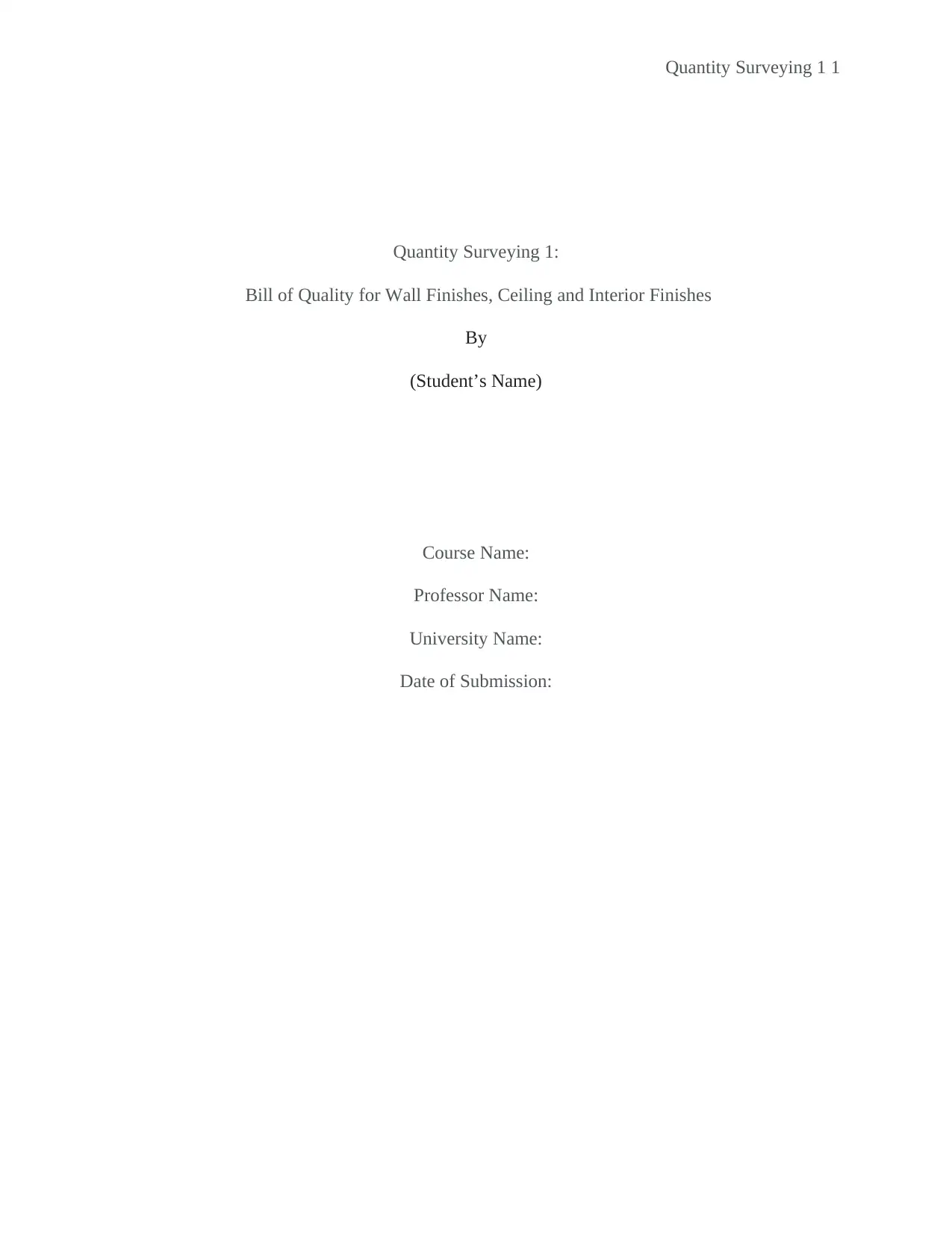
Quantity Surveying 1 1
Quantity Surveying 1:
Bill of Quality for Wall Finishes, Ceiling and Interior Finishes
By
(Student’s Name)
Course Name:
Professor Name:
University Name:
Date of Submission:
Quantity Surveying 1:
Bill of Quality for Wall Finishes, Ceiling and Interior Finishes
By
(Student’s Name)
Course Name:
Professor Name:
University Name:
Date of Submission:
Paraphrase This Document
Need a fresh take? Get an instant paraphrase of this document with our AI Paraphraser
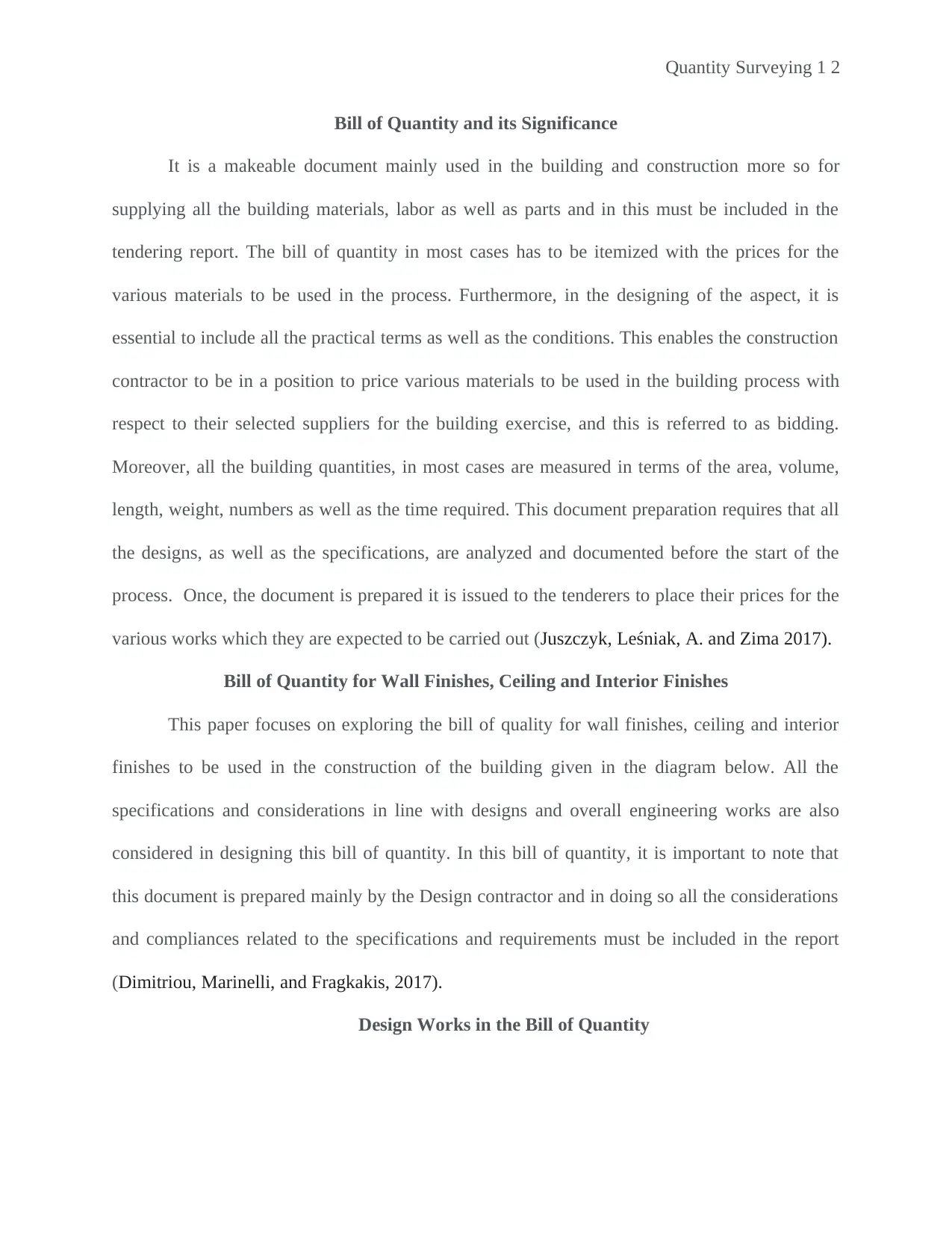
Quantity Surveying 1 2
Bill of Quantity and its Significance
It is a makeable document mainly used in the building and construction more so for
supplying all the building materials, labor as well as parts and in this must be included in the
tendering report. The bill of quantity in most cases has to be itemized with the prices for the
various materials to be used in the process. Furthermore, in the designing of the aspect, it is
essential to include all the practical terms as well as the conditions. This enables the construction
contractor to be in a position to price various materials to be used in the building process with
respect to their selected suppliers for the building exercise, and this is referred to as bidding.
Moreover, all the building quantities, in most cases are measured in terms of the area, volume,
length, weight, numbers as well as the time required. This document preparation requires that all
the designs, as well as the specifications, are analyzed and documented before the start of the
process. Once, the document is prepared it is issued to the tenderers to place their prices for the
various works which they are expected to be carried out (Juszczyk, Leśniak, A. and Zima 2017).
Bill of Quantity for Wall Finishes, Ceiling and Interior Finishes
This paper focuses on exploring the bill of quality for wall finishes, ceiling and interior
finishes to be used in the construction of the building given in the diagram below. All the
specifications and considerations in line with designs and overall engineering works are also
considered in designing this bill of quantity. In this bill of quantity, it is important to note that
this document is prepared mainly by the Design contractor and in doing so all the considerations
and compliances related to the specifications and requirements must be included in the report
(Dimitriou, Marinelli, and Fragkakis, 2017).
Design Works in the Bill of Quantity
Bill of Quantity and its Significance
It is a makeable document mainly used in the building and construction more so for
supplying all the building materials, labor as well as parts and in this must be included in the
tendering report. The bill of quantity in most cases has to be itemized with the prices for the
various materials to be used in the process. Furthermore, in the designing of the aspect, it is
essential to include all the practical terms as well as the conditions. This enables the construction
contractor to be in a position to price various materials to be used in the building process with
respect to their selected suppliers for the building exercise, and this is referred to as bidding.
Moreover, all the building quantities, in most cases are measured in terms of the area, volume,
length, weight, numbers as well as the time required. This document preparation requires that all
the designs, as well as the specifications, are analyzed and documented before the start of the
process. Once, the document is prepared it is issued to the tenderers to place their prices for the
various works which they are expected to be carried out (Juszczyk, Leśniak, A. and Zima 2017).
Bill of Quantity for Wall Finishes, Ceiling and Interior Finishes
This paper focuses on exploring the bill of quality for wall finishes, ceiling and interior
finishes to be used in the construction of the building given in the diagram below. All the
specifications and considerations in line with designs and overall engineering works are also
considered in designing this bill of quantity. In this bill of quantity, it is important to note that
this document is prepared mainly by the Design contractor and in doing so all the considerations
and compliances related to the specifications and requirements must be included in the report
(Dimitriou, Marinelli, and Fragkakis, 2017).
Design Works in the Bill of Quantity
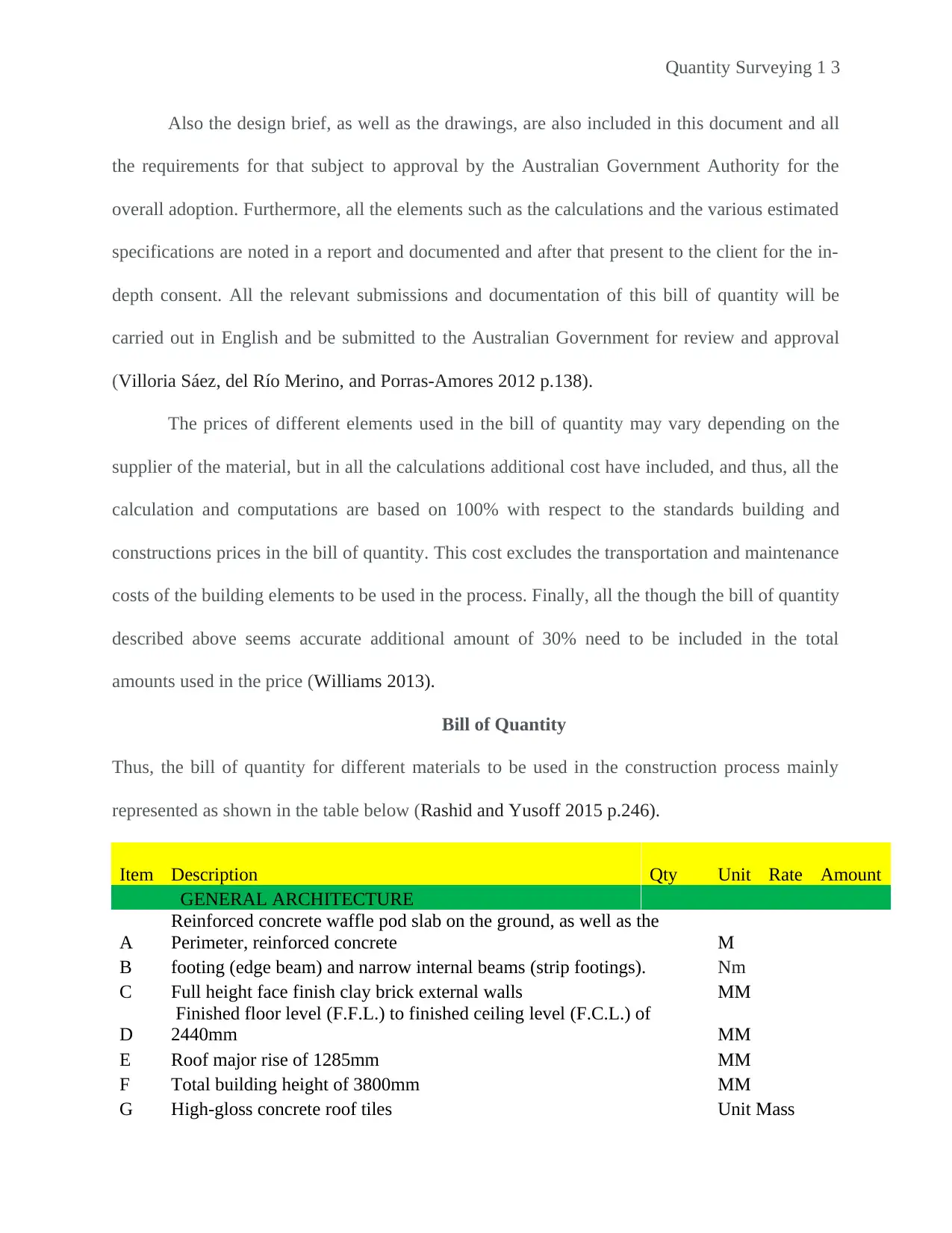
Quantity Surveying 1 3
Also the design brief, as well as the drawings, are also included in this document and all
the requirements for that subject to approval by the Australian Government Authority for the
overall adoption. Furthermore, all the elements such as the calculations and the various estimated
specifications are noted in a report and documented and after that present to the client for the in-
depth consent. All the relevant submissions and documentation of this bill of quantity will be
carried out in English and be submitted to the Australian Government for review and approval
(Villoria Sáez, del Río Merino, and Porras-Amores 2012 p.138).
The prices of different elements used in the bill of quantity may vary depending on the
supplier of the material, but in all the calculations additional cost have included, and thus, all the
calculation and computations are based on 100% with respect to the standards building and
constructions prices in the bill of quantity. This cost excludes the transportation and maintenance
costs of the building elements to be used in the process. Finally, all the though the bill of quantity
described above seems accurate additional amount of 30% need to be included in the total
amounts used in the price (Williams 2013).
Bill of Quantity
Thus, the bill of quantity for different materials to be used in the construction process mainly
represented as shown in the table below (Rashid and Yusoff 2015 p.246).
Item Description Qty Unit Rate Amount
GENERAL ARCHITECTURE
A
Reinforced concrete waffle pod slab on the ground, as well as the
Perimeter, reinforced concrete M
B footing (edge beam) and narrow internal beams (strip footings). Nm
C Full height face finish clay brick external walls MM
D
Finished floor level (F.F.L.) to finished ceiling level (F.C.L.) of
2440mm MM
E Roof major rise of 1285mm MM
F Total building height of 3800mm MM
G High-gloss concrete roof tiles Unit Mass
Also the design brief, as well as the drawings, are also included in this document and all
the requirements for that subject to approval by the Australian Government Authority for the
overall adoption. Furthermore, all the elements such as the calculations and the various estimated
specifications are noted in a report and documented and after that present to the client for the in-
depth consent. All the relevant submissions and documentation of this bill of quantity will be
carried out in English and be submitted to the Australian Government for review and approval
(Villoria Sáez, del Río Merino, and Porras-Amores 2012 p.138).
The prices of different elements used in the bill of quantity may vary depending on the
supplier of the material, but in all the calculations additional cost have included, and thus, all the
calculation and computations are based on 100% with respect to the standards building and
constructions prices in the bill of quantity. This cost excludes the transportation and maintenance
costs of the building elements to be used in the process. Finally, all the though the bill of quantity
described above seems accurate additional amount of 30% need to be included in the total
amounts used in the price (Williams 2013).
Bill of Quantity
Thus, the bill of quantity for different materials to be used in the construction process mainly
represented as shown in the table below (Rashid and Yusoff 2015 p.246).
Item Description Qty Unit Rate Amount
GENERAL ARCHITECTURE
A
Reinforced concrete waffle pod slab on the ground, as well as the
Perimeter, reinforced concrete M
B footing (edge beam) and narrow internal beams (strip footings). Nm
C Full height face finish clay brick external walls MM
D
Finished floor level (F.F.L.) to finished ceiling level (F.C.L.) of
2440mm MM
E Roof major rise of 1285mm MM
F Total building height of 3800mm MM
G High-gloss concrete roof tiles Unit Mass
⊘ This is a preview!⊘
Do you want full access?
Subscribe today to unlock all pages.

Trusted by 1+ million students worldwide
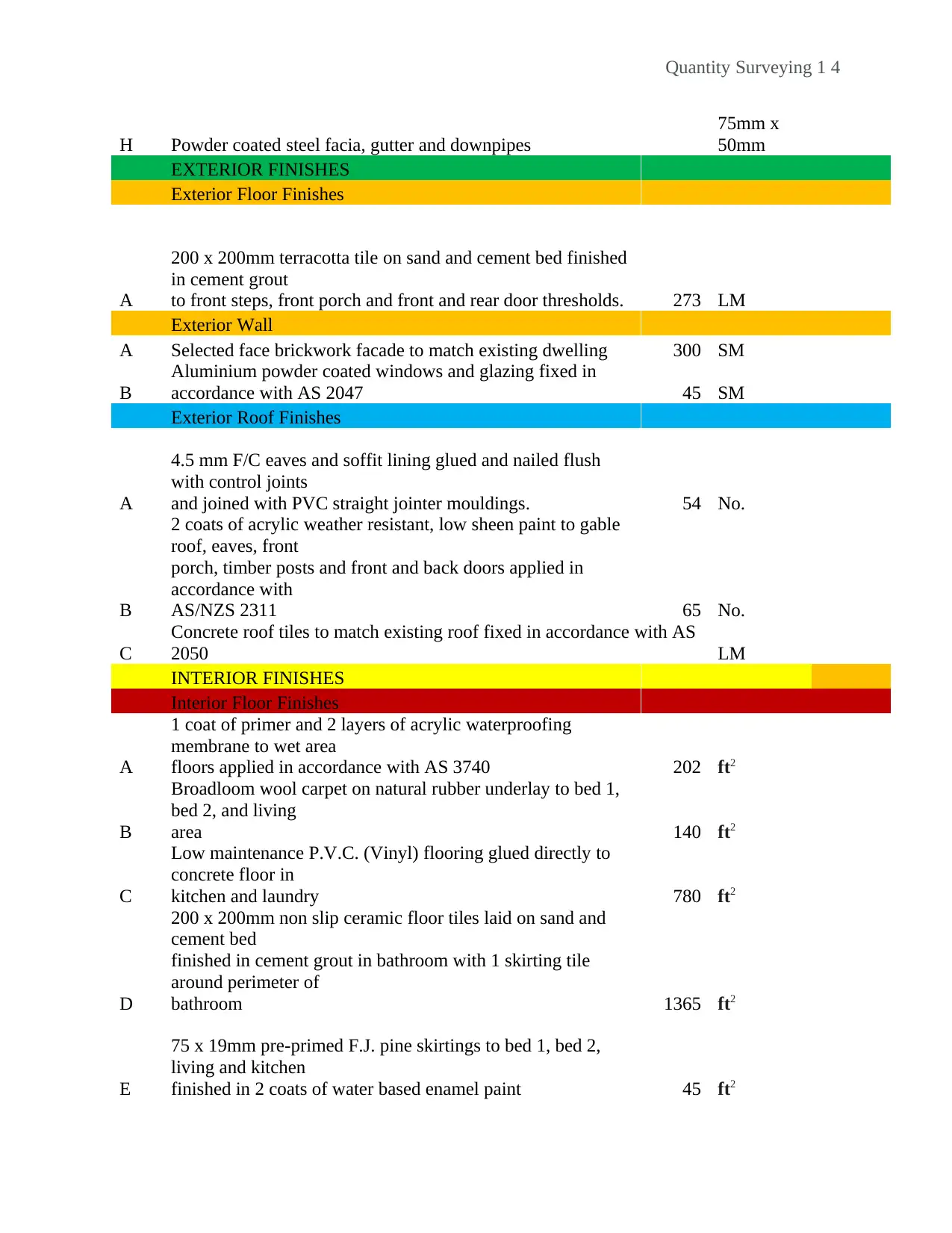
Quantity Surveying 1 4
H Powder coated steel facia, gutter and downpipes
75mm x
50mm
EXTERIOR FINISHES
Exterior Floor Finishes
A
200 x 200mm terracotta tile on sand and cement bed finished
in cement grout
to front steps, front porch and front and rear door thresholds. 273 LM
Exterior Wall
A Selected face brickwork facade to match existing dwelling 300 SM
B
Aluminium powder coated windows and glazing fixed in
accordance with AS 2047 45 SM
Exterior Roof Finishes
A
4.5 mm F/C eaves and soffit lining glued and nailed flush
with control joints
and joined with PVC straight jointer mouldings. 54 No.
B
2 coats of acrylic weather resistant, low sheen paint to gable
roof, eaves, front
porch, timber posts and front and back doors applied in
accordance with
AS/NZS 2311 65 No.
C
Concrete roof tiles to match existing roof fixed in accordance with AS
2050 LM
INTERIOR FINISHES
Interior Floor Finishes
A
1 coat of primer and 2 layers of acrylic waterproofing
membrane to wet area
floors applied in accordance with AS 3740 202 ft2
B
Broadloom wool carpet on natural rubber underlay to bed 1,
bed 2, and living
area 140 ft2
C
Low maintenance P.V.C. (Vinyl) flooring glued directly to
concrete floor in
kitchen and laundry 780 ft2
D
200 x 200mm non slip ceramic floor tiles laid on sand and
cement bed
finished in cement grout in bathroom with 1 skirting tile
around perimeter of
bathroom 1365 ft2
E
75 x 19mm pre-primed F.J. pine skirtings to bed 1, bed 2,
living and kitchen
finished in 2 coats of water based enamel paint 45 ft2
H Powder coated steel facia, gutter and downpipes
75mm x
50mm
EXTERIOR FINISHES
Exterior Floor Finishes
A
200 x 200mm terracotta tile on sand and cement bed finished
in cement grout
to front steps, front porch and front and rear door thresholds. 273 LM
Exterior Wall
A Selected face brickwork facade to match existing dwelling 300 SM
B
Aluminium powder coated windows and glazing fixed in
accordance with AS 2047 45 SM
Exterior Roof Finishes
A
4.5 mm F/C eaves and soffit lining glued and nailed flush
with control joints
and joined with PVC straight jointer mouldings. 54 No.
B
2 coats of acrylic weather resistant, low sheen paint to gable
roof, eaves, front
porch, timber posts and front and back doors applied in
accordance with
AS/NZS 2311 65 No.
C
Concrete roof tiles to match existing roof fixed in accordance with AS
2050 LM
INTERIOR FINISHES
Interior Floor Finishes
A
1 coat of primer and 2 layers of acrylic waterproofing
membrane to wet area
floors applied in accordance with AS 3740 202 ft2
B
Broadloom wool carpet on natural rubber underlay to bed 1,
bed 2, and living
area 140 ft2
C
Low maintenance P.V.C. (Vinyl) flooring glued directly to
concrete floor in
kitchen and laundry 780 ft2
D
200 x 200mm non slip ceramic floor tiles laid on sand and
cement bed
finished in cement grout in bathroom with 1 skirting tile
around perimeter of
bathroom 1365 ft2
E
75 x 19mm pre-primed F.J. pine skirtings to bed 1, bed 2,
living and kitchen
finished in 2 coats of water based enamel paint 45 ft2
Paraphrase This Document
Need a fresh take? Get an instant paraphrase of this document with our AI Paraphraser
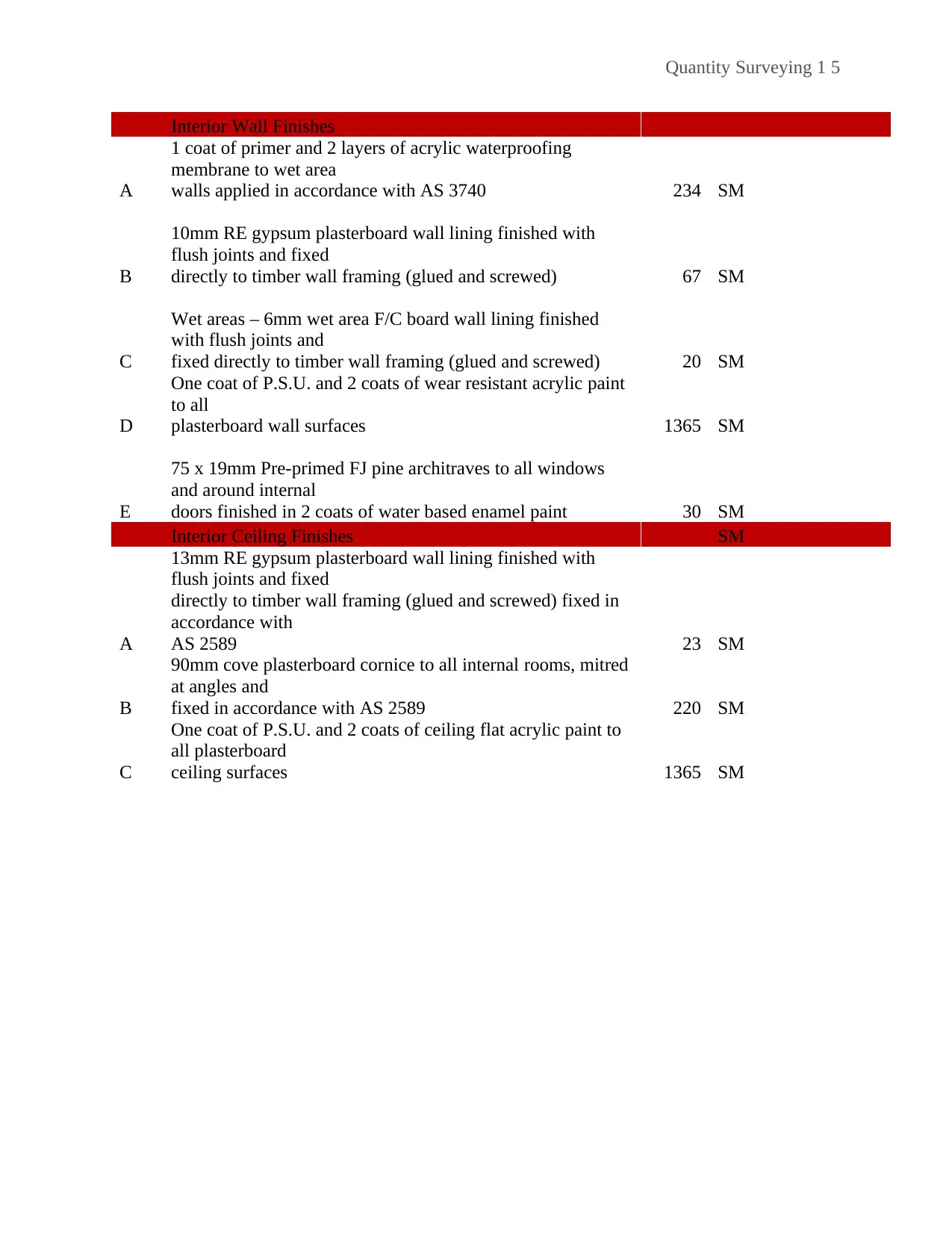
Quantity Surveying 1 5
Interior Wall Finishes
A
1 coat of primer and 2 layers of acrylic waterproofing
membrane to wet area
walls applied in accordance with AS 3740 234 SM
B
10mm RE gypsum plasterboard wall lining finished with
flush joints and fixed
directly to timber wall framing (glued and screwed) 67 SM
C
Wet areas – 6mm wet area F/C board wall lining finished
with flush joints and
fixed directly to timber wall framing (glued and screwed) 20 SM
D
One coat of P.S.U. and 2 coats of wear resistant acrylic paint
to all
plasterboard wall surfaces 1365 SM
E
75 x 19mm Pre-primed FJ pine architraves to all windows
and around internal
doors finished in 2 coats of water based enamel paint 30 SM
Interior Ceiling Finishes SM
A
13mm RE gypsum plasterboard wall lining finished with
flush joints and fixed
directly to timber wall framing (glued and screwed) fixed in
accordance with
AS 2589 23 SM
B
90mm cove plasterboard cornice to all internal rooms, mitred
at angles and
fixed in accordance with AS 2589 220 SM
C
One coat of P.S.U. and 2 coats of ceiling flat acrylic paint to
all plasterboard
ceiling surfaces 1365 SM
Interior Wall Finishes
A
1 coat of primer and 2 layers of acrylic waterproofing
membrane to wet area
walls applied in accordance with AS 3740 234 SM
B
10mm RE gypsum plasterboard wall lining finished with
flush joints and fixed
directly to timber wall framing (glued and screwed) 67 SM
C
Wet areas – 6mm wet area F/C board wall lining finished
with flush joints and
fixed directly to timber wall framing (glued and screwed) 20 SM
D
One coat of P.S.U. and 2 coats of wear resistant acrylic paint
to all
plasterboard wall surfaces 1365 SM
E
75 x 19mm Pre-primed FJ pine architraves to all windows
and around internal
doors finished in 2 coats of water based enamel paint 30 SM
Interior Ceiling Finishes SM
A
13mm RE gypsum plasterboard wall lining finished with
flush joints and fixed
directly to timber wall framing (glued and screwed) fixed in
accordance with
AS 2589 23 SM
B
90mm cove plasterboard cornice to all internal rooms, mitred
at angles and
fixed in accordance with AS 2589 220 SM
C
One coat of P.S.U. and 2 coats of ceiling flat acrylic paint to
all plasterboard
ceiling surfaces 1365 SM
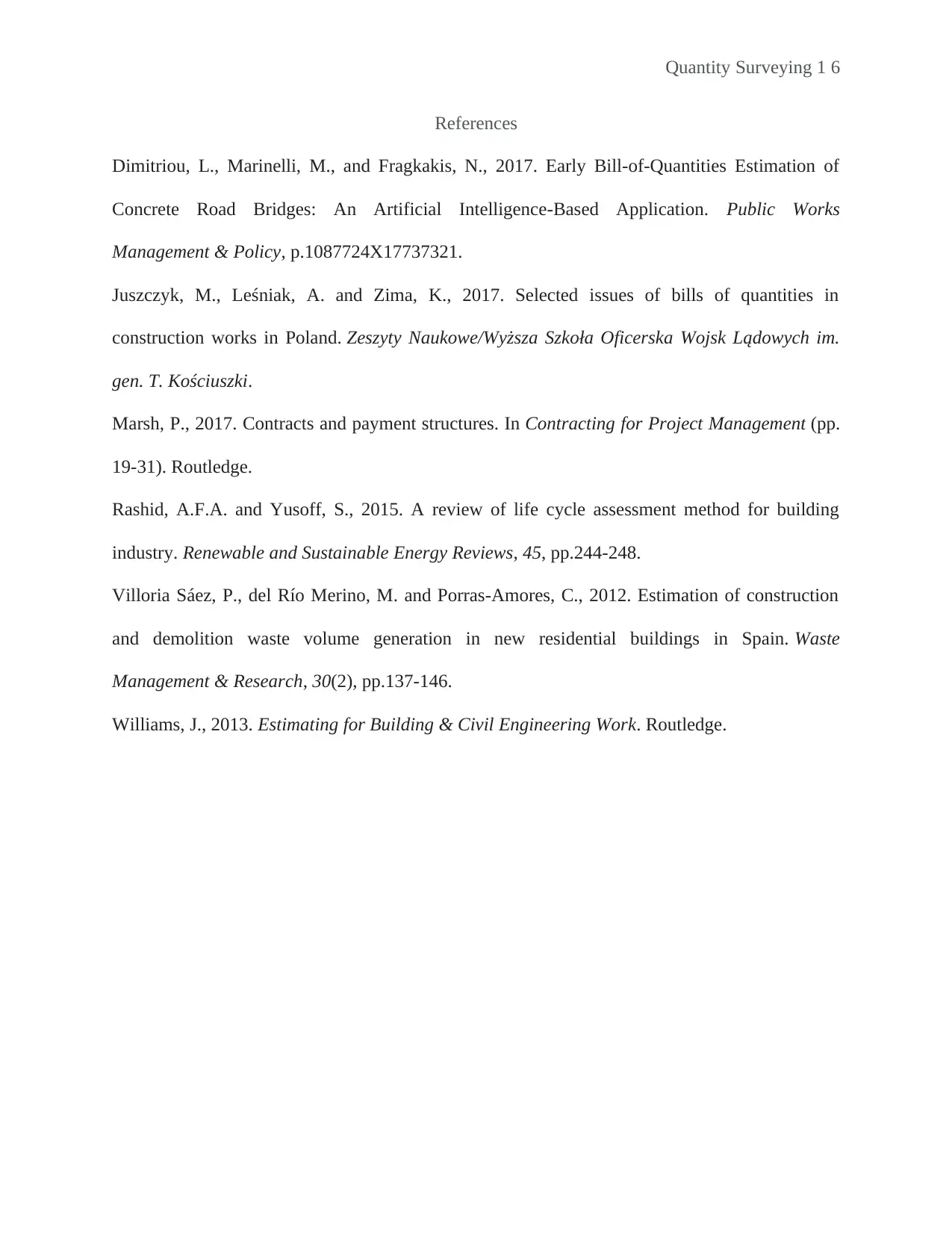
Quantity Surveying 1 6
References
Dimitriou, L., Marinelli, M., and Fragkakis, N., 2017. Early Bill-of-Quantities Estimation of
Concrete Road Bridges: An Artificial Intelligence-Based Application. Public Works
Management & Policy, p.1087724X17737321.
Juszczyk, M., Leśniak, A. and Zima, K., 2017. Selected issues of bills of quantities in
construction works in Poland. Zeszyty Naukowe/Wyższa Szkoła Oficerska Wojsk Lądowych im.
gen. T. Kościuszki.
Marsh, P., 2017. Contracts and payment structures. In Contracting for Project Management (pp.
19-31). Routledge.
Rashid, A.F.A. and Yusoff, S., 2015. A review of life cycle assessment method for building
industry. Renewable and Sustainable Energy Reviews, 45, pp.244-248.
Villoria Sáez, P., del Río Merino, M. and Porras-Amores, C., 2012. Estimation of construction
and demolition waste volume generation in new residential buildings in Spain. Waste
Management & Research, 30(2), pp.137-146.
Williams, J., 2013. Estimating for Building & Civil Engineering Work. Routledge.
References
Dimitriou, L., Marinelli, M., and Fragkakis, N., 2017. Early Bill-of-Quantities Estimation of
Concrete Road Bridges: An Artificial Intelligence-Based Application. Public Works
Management & Policy, p.1087724X17737321.
Juszczyk, M., Leśniak, A. and Zima, K., 2017. Selected issues of bills of quantities in
construction works in Poland. Zeszyty Naukowe/Wyższa Szkoła Oficerska Wojsk Lądowych im.
gen. T. Kościuszki.
Marsh, P., 2017. Contracts and payment structures. In Contracting for Project Management (pp.
19-31). Routledge.
Rashid, A.F.A. and Yusoff, S., 2015. A review of life cycle assessment method for building
industry. Renewable and Sustainable Energy Reviews, 45, pp.244-248.
Villoria Sáez, P., del Río Merino, M. and Porras-Amores, C., 2012. Estimation of construction
and demolition waste volume generation in new residential buildings in Spain. Waste
Management & Research, 30(2), pp.137-146.
Williams, J., 2013. Estimating for Building & Civil Engineering Work. Routledge.
⊘ This is a preview!⊘
Do you want full access?
Subscribe today to unlock all pages.

Trusted by 1+ million students worldwide
1 out of 6
Related Documents
Your All-in-One AI-Powered Toolkit for Academic Success.
+13062052269
info@desklib.com
Available 24*7 on WhatsApp / Email
![[object Object]](/_next/static/media/star-bottom.7253800d.svg)
Unlock your academic potential
Copyright © 2020–2025 A2Z Services. All Rights Reserved. Developed and managed by ZUCOL.





